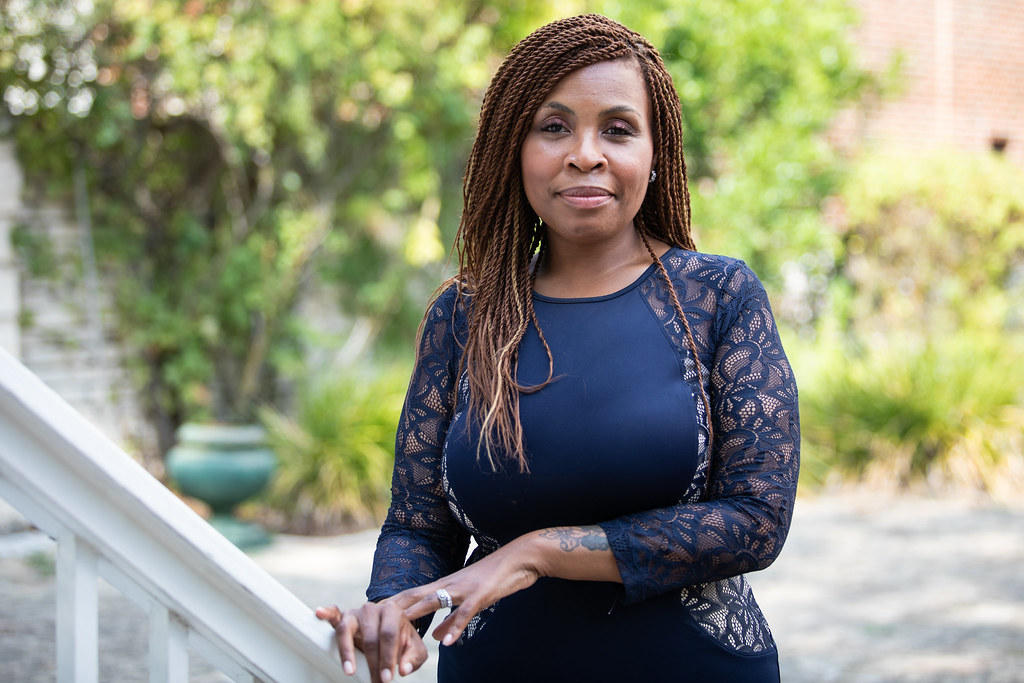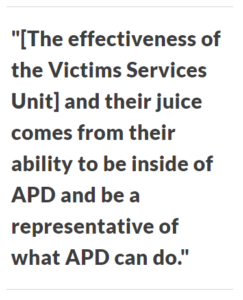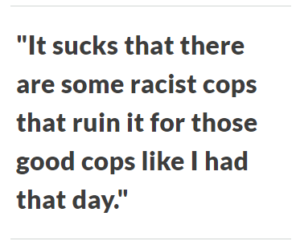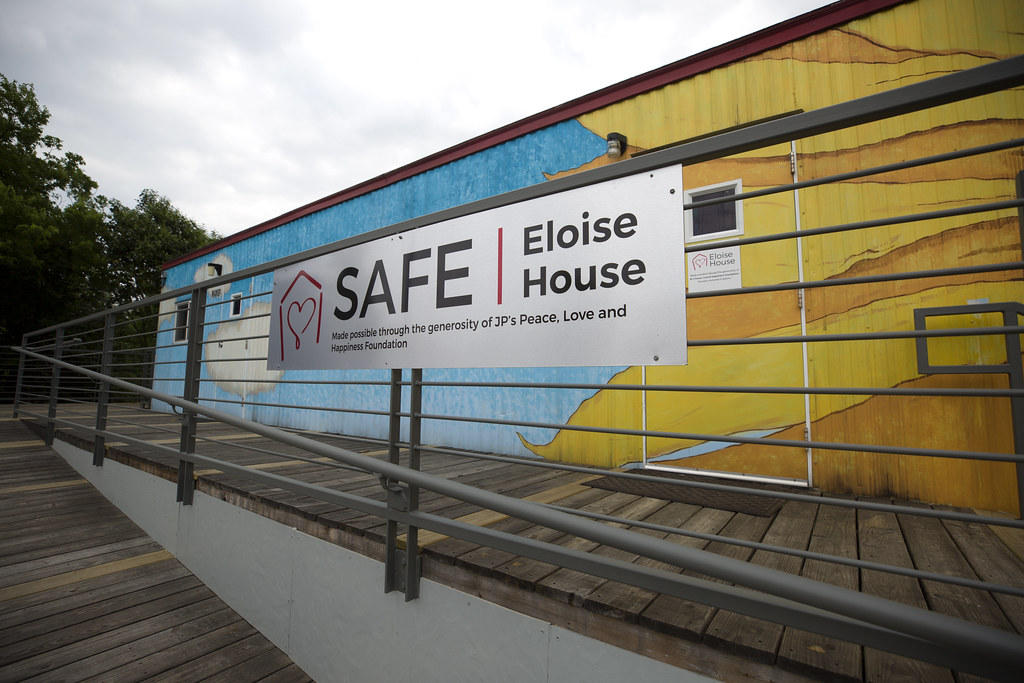Photo by Gabriel C. Perez/ KUT News
Austin could ‘decouple’ victim services from APD. Here’s what that would look like.
Thursday, September 3, 2020 by
Andrew Weber, KUT Twenty years ago, trombones were echoing in Courtney Santana’s ears – trombones like the ones in Charlie Brown cartoons.
There she was, crumpled on parking lot asphalt. Austin police officers were holding her two kids, including her 8-month-old son, who had nearly been shot in the head after her partner’s pistol fell out of a coat and discharged.
“I heard them cooing with them and laughing and bouncing them up and down, and they were like, ‘Mommy’s OK, Mommy’s all right,'” she said. “And I’m sitting there having a mental breakdown in front of the kids.”
Santana had seen the gun before; her partner had threatened her with it. But until that shot rang out, she said, the fighting and the threats and the violence seemed surmountable. It was like a dance that just kept going on and on and on.

Courtney Santana got out of an abusive situation and found shelter with the help of Austin police officers. Now she’s an advocate for survivors. Credit Michael Minasi / KUT
“That day I was just like, if this is not something I should be doing, show me a sign right away,” she said. “And that gun shooting over my son’s head was the sign I needed to get out and go to the shelter.”
She called 911, met those two officers and got connected with help. She says it saved her life.
Now an advocate for people going through similar situations, Santana works with police on a daily basis, mainly through the Austin Police Department’s Victim Services Unit. The team of case managers and counselors helps survivors of domestic and family violence, child abuse and sexual assault get help when they’re in crisis.
As Austin reconsiders its philosophy on policing, the unit – which handles roughly 8,400 cases a year – is slated to be moved out of APD.
Services Reimagined
Victim Services is one of a handful of units that are being “decoupled” from APD after city leaders decided to scale back the department’s budget by roughly $21 million immediately – and potentially as much as $150 million over the next year.
“Decoupling” is a city-speak term with a lot of outcomes – all of which are to be determined. Austin City Council pledged community input and another vote before anything is finalized. But the discussion right now is centered around moving that unit, and its 41 non-sworn officers, either out of APD and into a separate city office or out of its current chain of command within the department.
The decision was met with some skepticism, as it seemed the historically underfunded and understaffed unit could lose out on crucial resources. Those working in domestic violence response feared it could place Victim Services outside of the system, where advocates like Santana work.

Years after police helped her, Santana started Survive 2 Thrive, a nonprofit that helps people find shelter following domestic and family violence incidents. She works alongside counselors and investigators from Victim Services, and says there’s an immeasurable benefit to their level of access within the department.
“They need those protections of the APD, so (decoupling) wouldn’t be a good deal. … Their effectiveness and their juice comes from their ability to be inside of APD and be a representative of what APD can do,” she said. “You take them out, then they become like us, and they’ll be a little bit less effective than they are right now.”
Santana and other advocates worry about maintaining the level of access to 911 calls, criminal background searches and Versadex, APD’s electronic records-management system.
Kachina Clark, who heads up Victim Services, says that digital access is crucial.
“If we were to be moved to another city department, I’m not sure that we could continue to legally have access – or the full level of access that we have now,” she said.
Council Member Greg Casar, who along with Council Member Alison Alter, pushed to separate the unit from APD, says it would happen only if that access were guaranteed.
Just after the city passed its budget, the Austin-Travis County Family Violence Task Force called on city leaders to reconsider the decision to move Victim Services – especially because of an increase in reports of abuse during the pandemic.
“The pandemic has exacerbated the need for urgency in managing this issue,” the task force said in a letter. “We believe that the best way to do this is by keeping Victim Services housed at APD.”
Casar argues moving the unit would give it more autonomy over its budget and “elevate” its stature as far as budgetary and staffing discussions go. He said access to call data and everything else would be guaranteed.
“We want Victim Services to maintain the level of access that they have, but we also want to grow their influence,” he said. “And a lot of times, in a big organization like the city of Austin, if you are supervised by somebody else’s middle-manager supervisor, then you have less autonomy and less power.”
‘The Feather and the Sword’
Physical proximity to police officers is just as crucial as that digital access.
Because they work in the same building as officers responding to calls, investigators and counselors can coordinate responses and interview survivors who may need housing assistance or are pursuing protective orders.
Clark says that assistance has proved essential for APD officers answering calls during the pandemic. Counselors are often better able to assist and calm down people who are in crisis, allowing them to recall details more clearly, which can lead to a more effective investigation overall.
As APD pared back some units at the start of Covid-19, the department had Victim Services employees working calls remotely. It didn’t last long.
“Patrol officers very quickly requested they come back and respond in person,” she said. “(Officers) really have become, I think, very dependent on the counselors for getting better information.”

And Clark argues the counselors, in tandem with officers, leave a good first impression on abuse victims, which makes them more likely to engage with investigations and continue to seek services like shelter.
That first interaction is key, Clark says, and Santana agrees. She likens the tandem to a “feather and a sword” – one offering protection, while the other offers services to get people out of potentially fatal situations.
If not for those officers who helped her 20 years ago, Santana says, she’d be dead. But that kind of assistance isn’t what stands out in the minds of people focused on systemic inequities in policing right now.
“It sucks that there are some racist cops that ruin it for those good cops like I had that day,” she said. “I had an amazing experience. And then they’re holding my kids who have recovered from seeing their mom lose it. And they were talking me into going to the shelter. And I called the shelter right after I left them.”
But as an advocate now, she said she’s heard horror stories of how officers aren’t all well-equipped to deal with these situations. She says she wants whatever reforms come to the department to involve more training, which was included in the City Council budget.
She hopes that training better incorporates techniques used by counselors, which she argues would free patrol officers of liability and connect people with services more quickly. Now, she says, it’s a bit of a crap shoot: Some officers handle survivors’ trauma better than others.
If people knew what to expect, they also might be more open to reaching out for help.
“If you can do that and move on, then that frees you of liability, the client is where they need to be, and you have done your job as an officer,” she said. “Because there’s no uniform, systematic way that they deal with victims of domestic violence, (for victims) it’s just kind of like, ‘I don’t know what I’m going to run into, so I would rather just not even call the cops at all.'”
Shelter In Place
In the fore of this debate is a very real concern over the increase in domestic violence and child abuse during the coronavirus pandemic.
Since the start of the pandemic, the SAFE Alliance, a nonprofit that serves as a countywide safety net for survivors of abuse, says it has seen a 30 percent increase over last year in calls to its hotline from people seeking help.
What’s more, says Juliana Gonzales, the group’s senior director for sexual assault and health services, the level of danger callers describe has increased as well. “It just seems to be sort of igniting existing violence and taking it to another level that’s much less safe,” they said.

The SAFE Alliance says it’s seen a 30 percent increase in domestic violence calls to its hotline over the past year. Credit Julia Reihs / KUT
But that spike isn’t necessarily translating into more protective orders, calls to police or cases filed in court.
According to the Travis County Attorney’s Office, the County Court at Law No. 4, which handles these cases, saw a 30 percent drop in cases between March 1 and Aug. 20, 2019, and the same period in 2020. Protective orders have largely kept pace with last year, though fewer were filed during the months Austin and Travis County’s lockdown orders were in effect.
In short, Gonzales said, law enforcement isn’t being engaged, because people are trapped in the homes in which they’re experiencing violence.
But even those who do call may not be comfortable taking the risk of leaving their homes because of Covid-19 concerns.
“We’ve been cautioned against going into the public, if you can avoid it,” Gonzales said. “So that the messaging in our city has been very much: Stay home and be safe. But for so many of our survivors, home is not a safe place to stay.”
On top of that, SAFE Alliance and other shelters have reduced their shelter beds because of the need to limit capacity and keep distance during the pandemic.
Looking Forward
During discussions on the future of Victim Services, City Council committed to expanding shelter capacity, including by purchasing a 70- to 100-room hotel that could shelter survivors of family violence.
That strategy was adopted from outside-the-system advocates like Santana, whose Survive 2 Thrive project began connecting people on shelter waiting lists with hotel rooms in 2013.
During the pandemic, she helped set up a 24/7 hotline and is rolling out an app to better reach survivors. She has also taken advantage of the glut of vacancies in Austin’s typically full hotels by negotiating with them to rent rooms to folks seeking shelter.
“We had two partner hotels in total and there was about 295 rooms leading up to Covid-19,” Santana said. “And then when Covid hit, we got instant access to about 1,600 rooms across the Austin area, and we’re adding more every day.”
Those rooms have helped shelter 136 families since April, a quarter of whom are on the path to getting permanent housing, Santana says. The lion’s share of those families found shelter through S2T within an hour.

While she’d like to see more investment in out-of-system advocates and nonprofits, Santana says Austin desperately needs systemic investment in shelter and in counselors at Victim Services.
The unit has 13 crisis counselors on staff who deal with the entire spectrum of cases in a city with a population that’s nearly a million.
“Thirteen in a city our size – and growing every day – is really not enough,” she said.
The city’s budget added three more full-time counselors this year, but Santana said Victim Services needs at least 25 full-time crisis counselors to properly address calls.
Historically, Casar said, the unit’s positioning within APD has left it to the will and whim of higher-ups who have not fought to expand it.
“It has been a real struggle over the course of years to get to where they are,” he said.
He said City Council has tried to rectify that, expanding the number of crisis counselors from just three in 2018.
Though the idea of decoupling Victims Services from APD may have seemed out of left field, it’s been on the Council’s radar for a while.
“I know for some people it seems really fast,” Casar said, “but we’re trying to be really deliberate and have a conversation over the next 12 months about how to best do that.”
That could include taking Victim Services out of its current chain of command, allowing the unit to directly answer to the Austin police chief or the city manager.
Whatever is decided, Clark said, she’s open to trying out a new system as long as it benefits Austinites who come to Victim Services for help.
“For us, if it’s a benefit for victims and survivors, then I’m open to hearing about it,” she said. “I mean, I’m open to hearing about anything, but we’d be open to doing something different. We just want to make sure we’re able to serve survivors in the most effective way possible.”
This story was produced as part of the Austin Monitor’s reporting partnership with KUT.
The Austin Monitor’s work is made possible by donations from the community. Though our reporting covers donors from time to time, we are careful to keep business and editorial efforts separate while maintaining transparency. A complete list of donors is available here, and our code of ethics is explained here.
You're a community leader
And we’re honored you look to us for serious, in-depth news. You know a strong community needs local and dedicated watchdog reporting. We’re here for you and that won’t change. Now will you take the powerful next step and support our nonprofit news organization?








